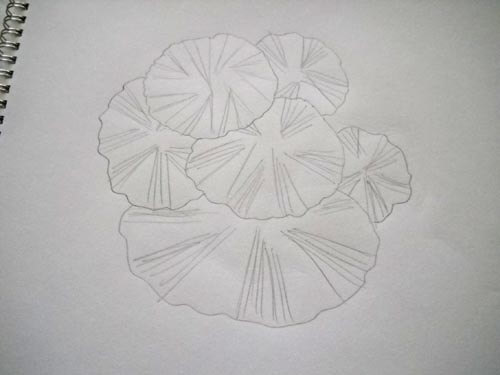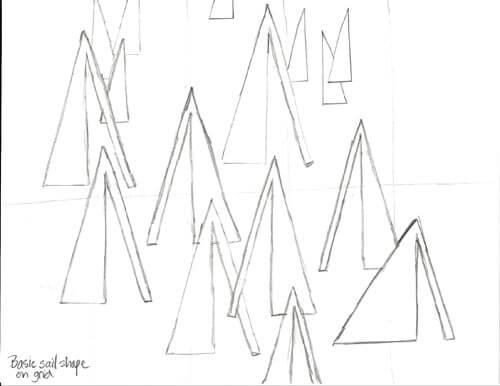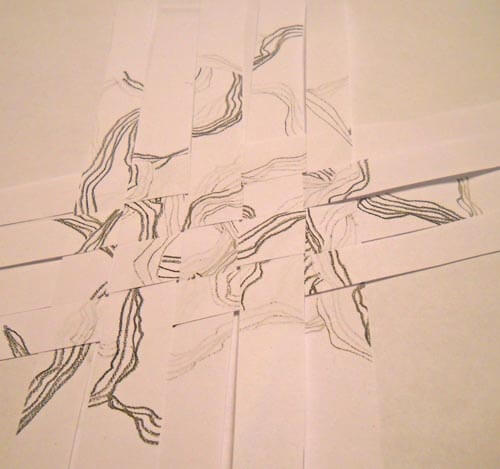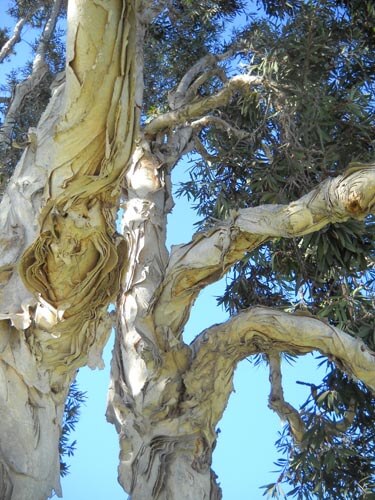Posts Tagged ‘Quilt University’
Free Motion Quilting – a New Design
 Oh my, have I learned some new stuff! The Free Motion Quilting challenge, hosted by SewCalGal, had a bonus tutorial by Susan Brubaker Knapp that piqued my interest. Basically you can create your own quilting design from your pictures. Well, I kinda figured you could, but once I read through this, I knew exactly how to do it. Bingo! I had loads of pictures that I would be able to use. I was having trouble with the drawing of the pattern for the August challenge; I planned to use that design on one of our bed stand runners. Now I had a new idea.
Oh my, have I learned some new stuff! The Free Motion Quilting challenge, hosted by SewCalGal, had a bonus tutorial by Susan Brubaker Knapp that piqued my interest. Basically you can create your own quilting design from your pictures. Well, I kinda figured you could, but once I read through this, I knew exactly how to do it. Bingo! I had loads of pictures that I would be able to use. I was having trouble with the drawing of the pattern for the August challenge; I planned to use that design on one of our bed stand runners. Now I had a new idea.
Concurrently, I am working on my Quilt University class, Inspired to Design, with Elizabeth Barton. I was looking at one of the photos I had morphed into a new design and suddenly realized I had a free motion quilting pattern right in front of me. Here’s the original picture:
Here’s the design element I developed a little further:
I added more pads to the design, made my pattern, and traced parts of it to the cotton. I realized, after my arms started to ache from tracing, that this was very free-flowing, so I really didn’t need to trace any more. I went with a brighter green for the outlines of the pads. Sometime in July I watched The Quilt Show episode on Stupendous Stitches, and after that I took a serious look at the other stitches on my Bernina workhorse 1008. Not many to work with, but I had one that I thought would work to give the idea of a ragged edge to the lily pad. Then I used a variegated green to do the stitching in each pad. I used a monofilament to create water waves on the rest of the background. Here it is:
Lessons Learned:
The background fabric actually worked pretty well, as did the thread colors. I wouldn’t stack the lily pads as much the next time. The most important lesson for me was going back and studying the original photo and realizing I could do much more with the interior lines. I became much more aware of that element in the original picture. I also did my binding a little differently, since I managed to cut it a half inch too thin. I used one of the stitches of a wave on the machine and made it very small. I tacked the binding down by maching, and you can’t really tell unless you’re looking at it close up.
And speaking of close-ups, here is one of the pads:
For the purposes of the table runner and the learning, I’m done. Next time I would use more color within the pads, spread the pads out more, and probably add stems. Overall, I love it! Thank you, Susan and SewCalGal!!
Analyzing an Artist – Jacob Lawrence
 Part of Lesson 2 is to look at designs in terms of basic elements of art. I chose Jacob Lawrence, as I have always been drawn to his paintings, both for story and simplicity. I saw a retrospective of his work at the Museum of Art in Houston the year I went to Quilt Market. All of his WWII paintings were grouped together, so you really got the narrative of that work.
Part of Lesson 2 is to look at designs in terms of basic elements of art. I chose Jacob Lawrence, as I have always been drawn to his paintings, both for story and simplicity. I saw a retrospective of his work at the Museum of Art in Houston the year I went to Quilt Market. All of his WWII paintings were grouped together, so you really got the narrative of that work.
I am very much a novice at doing this kind of critique – I always feel hampered by the lack of any formal art training, but I am curious to know why something appeals to me. So here goes. These paintings are a selection from a blog post on The Ragged Cloth Cafe, by Jane Davila.
Such a simple task and so lovely in composition. The vertical lines of the figures unify the painting, as do the irons. The lines of the irons are different, indicating the various stages of pressing. You can see the tension in each woman as she goes about her task, possibly as a result of the angles of the irons and the bent/angled heads in concentration. Balance and proportion: the irons seem very large, but they may be because I am looking at them from a modern perspective. I’ve never had to use heavy irons, and perhaps they were that big. The women dominate the painting, but I like that. This is “women’s work,” and that domination shows that. There is a lot of repetition in the postures, as well as in the background. I can almost get a “sweatshop” feel, and I get an image of the women from the movie The Help working and talking together. Perhaps the repetition helps to show community. Economy: again a simple task and a simple composition, but the focus is on the main idea. I can see the blue of the upper right pulling the eye to two of the ironed pieces; same for the orange and red in the upper left. The women themselves are dressed similarly, perhaps to indicate the uniform of the job. The more I look at this the more I see the strength and movement in the women, in their arms, the irons, their heads.
Now this next painting is one that doesn’t particularly appeal to me.
I find the colors very jarring, not at all harmonious. So many diagonals that my eye doesn’t want to rest at all. Again, a simple task at the barber shop, but there doesn’t seem to be the rhythm to the task as in the above painting. Unity/harmony: seems to be only in the main idea, that of a busy barbershop. Skin color is a unifying element. The faces seem to be the last thing you notice, just a few lighter lines. Interesting, in that may be a comment on the invisibility of the black community or the black man. Please note I am making that comment strictly from a white historical perspective. In terms of variety/tension, there certainly is a lot going on in this painting, indicating to me a very busy barber shop, and yet, now that I’ve noticed it, one man is smoking – that little bit of white draws your eye to the center of the painting. Balance/proportion: the piece seems very heavy on the bottom, big heavy dark triangles. The shampoo capes (for lack of a better term) are too many colors for my taste, and I think that’s what throws everything off for me.
Interesting exercise. I like having a selection of terms to work with, and I found I saw more in the painting the more I looked at it. But nothing beats seeing the work in person! What else can you add to the analyses? Comments welcome!
Design Class Continued……
 I’ve fallen a bit behind in my class through Quilt University, but I got myself somewhat back on track these past two nights, and I am learning some fascinating things through these exercises. First, I would never have attempted going beyond a basic picture or design like this on my own. It’s a case of “I don’t know what I don’t know.” These exercises are really stretching me, and what’s coming out is definitely intriguing.
I’ve fallen a bit behind in my class through Quilt University, but I got myself somewhat back on track these past two nights, and I am learning some fascinating things through these exercises. First, I would never have attempted going beyond a basic picture or design like this on my own. It’s a case of “I don’t know what I don’t know.” These exercises are really stretching me, and what’s coming out is definitely intriguing.
So here are the three basic pictures/sketches I have been working with and what has happened with them.
For this week I needed to take a basic design element and create a pattern with it on a grid. I chose a triangle for a sail, with a longer rectangle for a type of mast. As I was adding the pattern to the grid, I decided to flip the pattern, make some of different sizes, and make some small ones for depth in the distance.
It may not seem like much, but it was quite the departure from how I work, and I can definitely see possibilities with this sketch. From this point, we took a basic shape (again the triangle) and just worked on creating triangles. At one point I decided to fill in one of the triangles with a favorite zentangle, Paradox. It looked so cool, I decided to see what the sail pattern would look like. Again, definite possibilities.
I think there’s huge potential here.
Now here’s the second picture and sketch, a tree from Spanish Landing Park in San Diego.
 I worked with three different weights of pencils, and I really like this, plus as I work more with it, it is giving me some ideas for the driftwood piece. From here I sliced the piece in to strips and then wove them back into a new design. Very interesting activity.
I worked with three different weights of pencils, and I really like this, plus as I work more with it, it is giving me some ideas for the driftwood piece. From here I sliced the piece in to strips and then wove them back into a new design. Very interesting activity.
I didn’t really care for this one, as I felt there was too much negative space.
This seemed better, and while I know I am supposed to concentrate just on creating designs, I find myself thinking about moving into fabric, and I have a hard time imagining how this would happen with this design.
Here;s the sketch and the picture for the third one.
 This time I tried a different technique: I sliced the sketch and then put it back together, with each slice up or down of the other pieces.
This time I tried a different technique: I sliced the sketch and then put it back together, with each slice up or down of the other pieces.
With this one I could definitely see the idea of reflecting water.
There is a lot more to this lesson, and I think tomorrow I am going to look at more of the photos I shot in San Diego and evaluate them according to the principles of art. Then maybe I will feel like I have a better idea of the terminology and can try some new sketches.
Continuing Lesson 1
 I have been ruminating on finishing this first lesson in my Quilt University class, especially since I am now a week behind due to our vacation in San Diego. But it was not wasted time, even though I never opened the sketch book. The exercises I had done at the beginning caused me to start looking at my surroundings in terms of line and shape, focal points, unusual camera angles, and textures. I ended up with a lot of unusual shots, just to remind myself of what caught my eye.
I have been ruminating on finishing this first lesson in my Quilt University class, especially since I am now a week behind due to our vacation in San Diego. But it was not wasted time, even though I never opened the sketch book. The exercises I had done at the beginning caused me to start looking at my surroundings in terms of line and shape, focal points, unusual camera angles, and textures. I ended up with a lot of unusual shots, just to remind myself of what caught my eye.
Last night I sat down with my selected pictures, tracing paper, and my sketchbook to see just what I could come up with. First, here’s the original picture, from sitting in Spanish Landing Park and admiring all the boats, and masts, and straight lines….and triangles……
I cropped the picture and then used tracing paper to get basic outlines. I am not comfortable sketching freehand with this activity – it kind of intimidated me at first.
What I liked about this was that I could definitely see the trapezoids, triangles, and straight lines. From here I tried a grid to repeat some design elements.
Not happy with this – not at all pleasing to me. Probably because the exercise itself is so new. So worried – like always in the past – about what this was going to look like. Then I went to my triangles and straight lines:
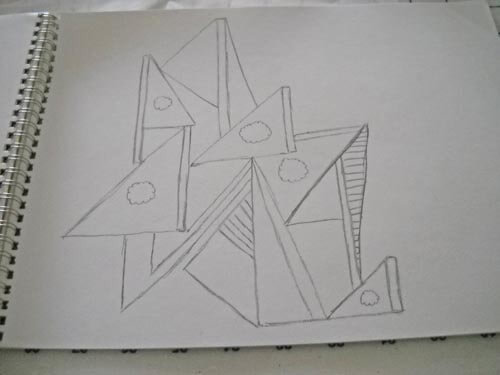 This has got possibilities, but it would seriously need reworking. I might pick up tree color in the sails. Once again, I can see just how linear I am in the design….
This has got possibilities, but it would seriously need reworking. I might pick up tree color in the sails. Once again, I can see just how linear I am in the design….
From here I went to the photo of what hubby and I called “our tree” at Spanish Landing Park, since we sat next to it for three days. Here’s the original:
I ended up turning this on its side for the outline – something I NEVER do with a picture…..and I liked it!
I already could see some possibilities in this, and at this point I was kind of amazed at how my thinking was changing. In the past I had always looked at trying to work with the whole composition, instead of just pieces of it.
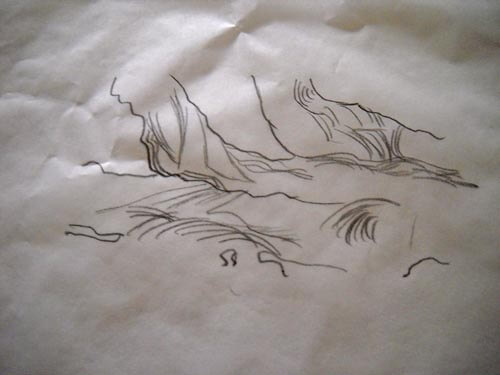 Here’s the close-up, and as I was trying to add some texture, it occurred to me that all the lines were pretty much ovals…..the beginning of inspiration and a real change in my thinking, which led to this…..
Here’s the close-up, and as I was trying to add some texture, it occurred to me that all the lines were pretty much ovals…..the beginning of inspiration and a real change in my thinking, which led to this…..
I LOVE this! The linear part of me was going to do all the ovals equidistant apart, but I had trouble with that in the second line and I realized the wonkiness of the “in and out” of the line gave me even more texture. Then when I changed pencil hardness I was really hooked……which led to “Oh, my, I need more thread and yarns….” I think I’m on to something. Plus, this was so freeing. This process really works, and I can see working this activity much more.
So then I went to another photo:
This was taken in Balboa Park, the reflecting pools near the Botanical Gardens. LOVE these lily pads, especially the variegated leaves. Here’s the outline.
And here’s the close-up:
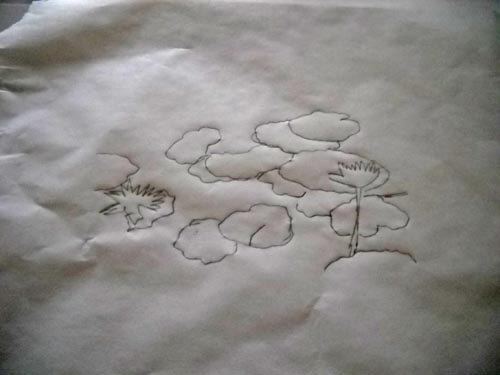 I really like the shape of the lily pad, so I decided to use not-quite-regular circles. I ended up with this, and again, really happy with it. I already know what stitches I would use….and again, I need more thread…..
I really like the shape of the lily pad, so I decided to use not-quite-regular circles. I ended up with this, and again, really happy with it. I already know what stitches I would use….and again, I need more thread…..
I have a couple of additional photos I want to do this exercise with, and I can see myself using it a lot. I had ideas come out that I wouldn’t have seen otherwise. Definite progress.
Work-in-Progress Wednesday
 It’s usually about this time every summer that I become productive, knowing that my time is short before school starts. Not this year! I’ve been productive since the end of May, with a lot of projects in the works, and a whole bunch already completed. It feels very very good! The commission is done, I have two shows to create/finish pieces for, another commission to complete, a bunch of small studies to do, and about 6 unfinished quilts that have been around for a lot of years (some more than a decade). I do LOVE being productive, busy, and above all creative.
It’s usually about this time every summer that I become productive, knowing that my time is short before school starts. Not this year! I’ve been productive since the end of May, with a lot of projects in the works, and a whole bunch already completed. It feels very very good! The commission is done, I have two shows to create/finish pieces for, another commission to complete, a bunch of small studies to do, and about 6 unfinished quilts that have been around for a lot of years (some more than a decade). I do LOVE being productive, busy, and above all creative.
Now, I finished another small study on movement for the class I’m taking from Lyric Kinard and Quilt University. I realized as I finished quilting that I really do need to take a “before and after” photo of the fabric, because there really is a dramatic difference. For this piece, I tried a new marbling pattern – actually, I tried to create a pattern that would show movement. I really liked what I came up with – very festive, 4th-of-July feeling. The question was could I make it feel even more of an explosion with movement. I wanted to put this up for a challenge using the word “spark.” I thought of fire crackers, and then I wanted to combine it with the class assignment. Click so you could see the details.
One thing I have found as a result of the class – well, two things actually – I now feel I can create any type of line I want with my quilting, and I spend a lot more time thinking about how the quilting will accent the message of the piece. I started by doing a “loop” in free motion from the very center outward to the edge of the “center.” From there I quilted lines to accent the “rays” from the center of the piece. I used a Superior metallic for the center, and three different threads for the outer rays – a Rainbow in purple, yellow, and green, and two shades of gold metallic.
Already I was seeing more movement in the piece – but I wanted more….So I took the multicolored thread and stitched from the center out in a zigzag motion to add more of an explosive effect. Better. Then I took one of the metallics and did the same thing outside of the circle, but less dense than the previous. I did an “envelope” backing, and I am going to experiment with mounting this on canvas to see how it works/looks.
Overall, very pleased. I just wish I had the “before” picture. With that in mind, here are the “befores” for two more small studies in the works:
I will be curious to see how they work out and what they have to teach me.
Taking Online Classes
One of the things I promised myself with retirement is that I would take some classes, whether at the community college or on line. I found a new class at Quilt University by Lyric Kinard – The Artist’s Toolbox. This is my third class at QU, and I have been very pleased with the courses – good instructions, lots of great ideas for projects, and really helpful instructors. I actually completed almost all of the small sewing projects that practice the various elements of art, and I am learning a good deal. Part of what I am seeing is why some of my work really comes together and what’s missing in some other pieces. Very valuable, and I have a few studies left to complete.
Lyric Kinard, one of the instructors at QU, has a great website. Her fiber art demonstrates all of the principles she teaches in The Artist’s Toolbox – I am hoping she offers a part 2 to this class. Plus, she keeps a running list of art shows to enter, so you can always check and see what’s available.
I also just finished a class on Multiple Streams of Income, since I am focused on building my business. Laura Bray did an excellent job in not only presenting resources, but also in having a lot of guest speakers who do on a daily basis what needs to be done to build additional sources of income. Sign up for her newsletter so you know when she offers classes, and sign up to read her blog. The “focusing” piece, as well as the “goals” piece were absolutely invaluable to me. I was getting bogged down in marketing, but it wasn’t furthering what I actually wanted to accomplish. Until I did my 90-day goals, I didn’t see this. Now I can be much more focused on my individual goals, rather than the hit-and-miss of before. Click here to visit katydid designs.
Online classes really work for me, especially since I am no longer driving myself. I can work at my speed, have access to all my materials, and can correspond with loads of people. I keep myself motivated easily, so this form of instruction works for me. Your mileage may vary. I also enjoy reading blogs that have tutorials, as I usually like trying out something new. I plan on doing lots of that during retirement!

